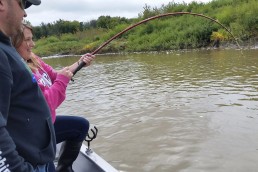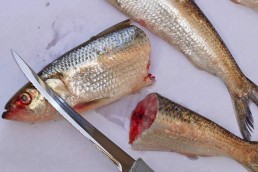Selecting the Right Lines for Catfish
SHARE THIS POST
Catfish fishing line options
Last month we discussed the kinds of hooks used for catfishing, because if you don’t know what type of hook you want to use, you won’t know what kind of rod to buy. Before we get into rods, however, we are going to discuss line. Because like hooks, the type of line you choose may play a factor in the kind of rods you want to purchase.
Discussing line for catfishing can literally cause fights to break out in some catfishing circles. I always joke about it in seminars, but I have actually had people get so mad over one kind of line or another that it is clearly taken more seriously that it should be.
So here is the question that starts it all: “Mono or braid?” And the answer is…whatever you prefer. Even with that simple answer, some arguments may get heated. Let’s break it down so you can see what you prefer.
The proper strength of line is determined by where you’re fishing and what you are fishing for. If you fish most channel cat waters in the United States, 12- to 17-pound-test line is about all you need. If you fish places like the Red River, or places wherever there can be numerous fish that run 15 to 30 pounds, I recommend using 30-pound line. Of course, as the fish get bigger, so should your line. For example, if you are fishing for giant blue or flathead catfish, you will want a 50- to 80-pound line to be safe. It is good practice to find the right line for the job, rather than just get the toughest line you can find. I use 30-pound mono exclusively on the Red River flowing between Minnesota and North Dakota, where 20-pound-plus channel cats are common.
Monofilament for catfish
Mono is tried-and-true for most catfish anglers–me included. Mono can be found just about anywhere you would purchase fishing gear. It is very inexpensive, strong, abrasion-resistant, and from a guide’s perspective, it is very forgiving. It also breaks much easier than other lines when you snag up.
While this seems like really great stuff so far, there are a few negatives to mono. It is thicker than braided line, so there is more drag in the water, especially if you are drifting or trolling. It stretches, requiring a hookset to have to pull the stretch out. Sometimes, this stretch can weaken the line, causing a breakoff. It also has memory, which you can clearly tell when it has been on your real for an extended period of time. In catfishing, this is all quite minute, but some anglers make it a bigger deal than it really is.
Braid for catfish
Braided superline has its place in catfishing, for sure. Braid has no stretch, so it sets hooks right now when you pull back on the rod. It has far less diameter, making it glide through the water easier when drifting or trolling. Braid also has no memory.
The downfalls to braided lines are because of its small diameter; anglers buy heavier line with the idea that bigger is better. This can damage your rod eyelets, and make breaking the line in case of snags downright miserable. Quality braided line is also three or four times more expensive than mono. Another overlooked thing with braided lines is that they do not like sharp rocks. (No line likes rocks, but braids seem to not hold up as well as mono.)
Fluorocarbon for catfish
Fluorocarbon is a third kind of line that is sometimes used in catfishing as a leader material. It is said to be the strongest, most abrasion-resistant line on the market, yet it is not used very much in catfishing. Expense is the biggest reason for fluoro not being used for much more than leader making material in catfishing.
When to use which line
I stated earlier that I am a mono guy. I will tell you exactly why, too. As a guide, I keep 12 to 14 rigs spooled up and ready to go at any given time. To spool everything up with mono costs me about $50, whereas to spool that up with braid would run me over $200.
Are you enjoying this post?
You can be among the first to get the latest info on where to go, what to use and how to use it!
Next, I fish under anchor most of the time, near rocks, wood snags or many other structures that snag. Sometimes, breaking or cutting the line is the only option. The thicker diameter of mono makes it easier to hold onto to pull on and break the line, whereas braid cuts into your hands and is more difficult to break off. Mono again costs less to lose.
The stretch of mono is very forgiving, allowing a circle hook to turn in the fish’s mouth properly. It also allows inexperienced anglers to fight fish easier, as the stretch can make up for some wrong moves that may happen during the fight. It makes fighting a big fish virtually foolproof.
Sometimes, when the fish are biting lighter, the non-stretch factors of braid can be an advantage, because it will turn the hook faster and allow for a quicker hookset. Or, sometimes you are fishing in heavy current and need the line to cut the water better; braid is great for this job as well. Of course, braid allows you to have a stronger line without taking up more space on your reel.
Leaders
No matter which type of line you choose to use in your catfishing, it is imperative that you use mono or fluorocarbon for your leaders. The stretch in mono takes the initial shock of a hit, whereas braid doesn’t provide any stretch. Mono leaders also allow for easier breaking when a hook gets caught in wood or other underwater hazards
Some say fluorocarbon is the best leader material going, because it is so abrasion-resistant. This may be true but for the price of fluoro, and the fact that it is so heat sensitive when tying knots that it tends to not be a popular choice among catfish anglers.
It is very important to keep all leaders fresh. After a few fish are caught, or the lines are dragged over some sharp-feeling debris, it is good practice to inspect and retie when needed. When I am on a good catfish bite with my guide service, I inspect the leaders on each fish and replace them when needed. I also retie each day to ensure the next group will start with fresh leaders on each line to prevent any unnecessary breakoffs.
Line color
You are probably asking why color is mentioned here. If you catfish, you already know the answer to this question. But if you don’t, you should know that having a brightly colored line for catfishing is important. It has nothing to do with the fish; it has everything to do with you. Many times, catfish anglers fish multiple lines and spend much of their fishing time during low-light conditions. Bright colors such as neon green, yellow or orange help keep the lines in order and enable you to see what is going on.
Most catfish live in dark or muddy water, and with their aggression, they just don’t care about line color. So do yourself a favor and spool up bright line. It will make your catfishing life ever so much easier.
In the end, it is up to you to come up with the line that you prefer and determine what you have confidence in. You now understand the advantages and disadvantages of both and when each is at their best.
Now that you have a grasp on hook (see last month’s issue) and line options, we can explain the proper rod for the job. Next month, we will break down pairing the perfect rod to hooks and lines to catch your catfish of a lifetime. MWO
Capt. Brad Durick is a nationally recognized catfish guide on the Red River of the North, seminar speaker and author of the books Cracking the Channel Catfish Code and Advanced Catfishing Made Easy. For more information, go to redrivercatfish.com.
For more information on catfish gear, check out this article on catfish rod selection.
MWO
SHARE THIS POST
Did you enjoy this post?
You can be among the first to get the latest info on where to go, what to use and how to use it!
Brad Durick
Captain Brad Durick is a nationally recognized catfish guide, seminar speaker, and author of the books Cracking the Channel Catfish Code and Advanced Catfishing Made Easy. For more information: redrivercatfish.com or facebook.com/braddurickoutdoors.



